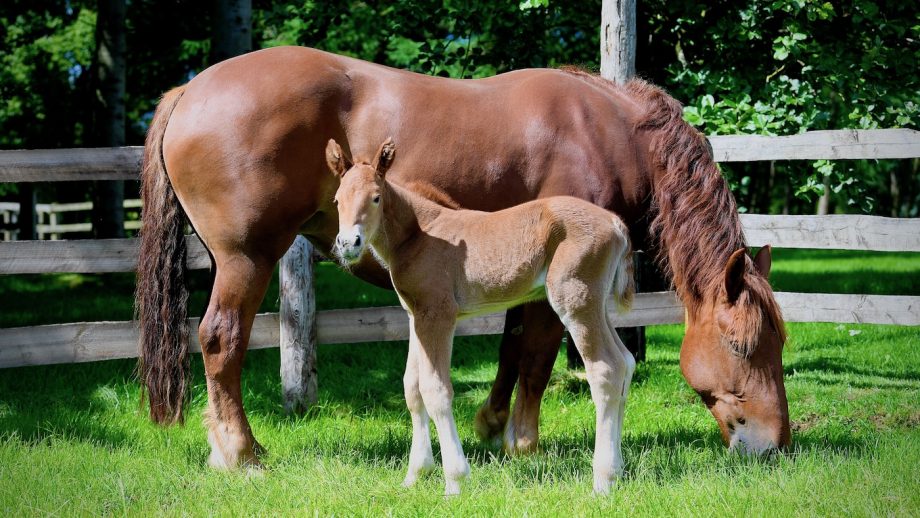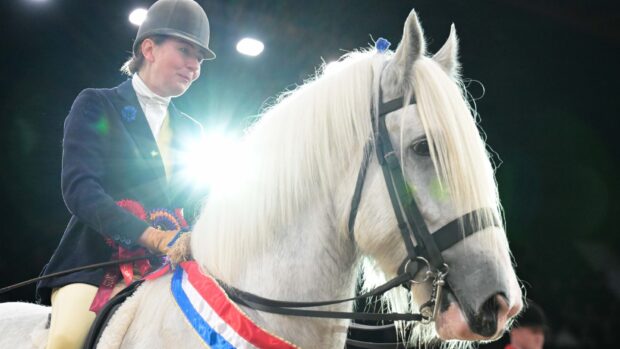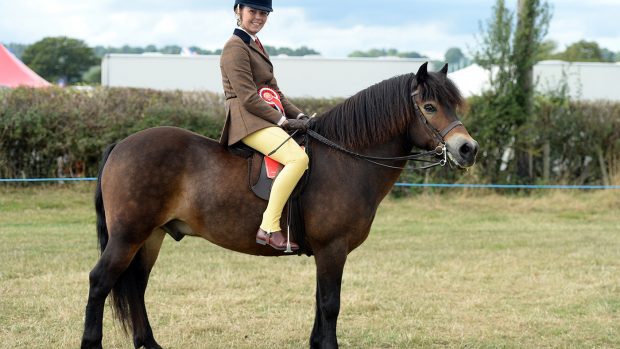Riders are urged not to overlook native breeds if they want to compete; as industry experts say celebrating all our rare breeds are capable of is key to securing their survival
CELEBRATING the range of jobs native breeds can do is key if rare equines are to survive and thrive in today’s world.
The call came at the Rare Breeds Survival Trust (RBST) Scotland “Back to the Future” virtual conference on 31 March.
{"content":"PHA+QW5kcmVhIFBhcnJ5LUpvbmVzLCBSQlNUIGZhcm0gcGFyayBwcm9qZWN0IG9mZmljZXIsIHVyZ2VkIHBlb3BsZSBub3QgdG8g4oCcb3Zlcmxvb2vigJ0gbmF0aXZlIGJyZWVkcyBmb3IgY29tcGV0aXRpb24uPC9wPgo8cD7igJxQZW9wbGUgYmVsaWV2ZSB0aGV5IG5lZWQgYSBzcG9ydCBob3JzZSBvciBhIHdhcm1ibG9vZCwgb3Igc29tZXRoaW5nIGJpZyBhbmQgZmxhc2h5IHRoZXNlIGRheXMgdG8gY29tcGV0ZSwgYnV0IHRoZXkgZG9u4oCZdCzigJ0gc2hlIHNhaWQuPC9wPgo8cD7igJxJIGtub3cgcGxlbnR5IG9mIDxhIGhyZWY9Imh0dHBzOi8vd3d3LmhvcnNlYW5kaG91bmQuY28udWsvdGFnL2hpZ2hsYW5kcyI+SGlnaGxhbmQ8L2E+IHBvbmllcywgZm9yIGluc3RhbmNlLCB3aG8gZG8gZHJlc3NhZ2UsIHRoZXkgaHVudCwgc2hvdywgd29yayBhbmQgdGhleSBtYWtlIGJyaWxsaWFudCBjaGlsZOKAmXMgcG9uaWVzIOKAkyBhbnlib2R54oCZcyByaWRlIOKAkyBhbmQgdGhleSBoYXZlIHRoZSBpbnRlbGxpZ2VuY2UgYW5kIHN1cmVmb290ZWRuZXNzIHRvIGRvIHRoZSBqb2IuPC9wPgo8cD48ZGl2IGNsYXNzPSJhZC1jb250YWluZXIgYWQtY29udGFpbmVyLS1tb2JpbGUiPjxkaXYgaWQ9InBvc3QtaW5saW5lLTIiIGNsYXNzPSJpcGMtYWR2ZXJ0Ij48L2Rpdj48L2Rpdj48c2VjdGlvbiBpZD0iZW1iZWRfY29kZS0zMSIgY2xhc3M9ImhpZGRlbi1tZCBoaWRkZW4tbGcgcy1jb250YWluZXIgc3RpY2t5LWFuY2hvciBoaWRlLXdpZGdldC10aXRsZSB3aWRnZXRfZW1iZWRfY29kZSBwcmVtaXVtX2lubGluZV8yIj48c2VjdGlvbiBjbGFzcz0icy1jb250YWluZXIgbGlzdGluZy0tc2luZ2xlIGxpc3RpbmctLXNpbmdsZS1zaGFyZXRocm91Z2ggaW1hZ2UtYXNwZWN0LWxhbmRzY2FwZSBkZWZhdWx0IHNoYXJldGhyb3VnaC1hZCBzaGFyZXRocm91Z2gtYWQtaGlkZGVuIj4NCiAgPGRpdiBjbGFzcz0icy1jb250YWluZXJfX2lubmVyIj4NCiAgICA8dWw+DQogICAgICA8bGkgaWQ9Im5hdGl2ZS1jb250ZW50LW1vYmlsZSIgY2xhc3M9Imxpc3RpbmctaXRlbSI+DQogICAgICA8L2xpPg0KICAgIDwvdWw+DQogIDwvZGl2Pg0KPC9zZWN0aW9uPjwvc2VjdGlvbj48L3A+CjxwPuKAnFRoZXJlIGFyZSBXZWxzaCBwb25pZXMgY29tcGV0aW5nIGF0IGludGVybmF0aW9uYWwgbGV2ZWwgZHJlc3NhZ2UsIGJ1dCBvZnRlbiBwZW9wbGUgdGhpbmsgYmVjYXVzZSB0aGV5IGFyZSBuYXRpdmUsIGFuZCBzbWFsbGVyLCB0aGV5IHdvbuKAmXQgbmVjZXNzYXJpbHkgZG8gdGhlIGpvYi4gSeKAmXZlIGZvdW5kIHRoYXQgbG9jYWxseSwgd2hldGhlciBvciBub3QgaXTigJlzIHRydWUgZXZlcnl3aGVyZS48L3A+CjxwPuKAnFRoZXnigJl2ZSBoYWQgdG8gZXZvbHZlIHRvIHN1cnZpdmUgaW4gdGhlIGVudmlyb25tZW50LCB0aGV5IGhhdmUgaW50ZWxsaWdlbmNlLCB0aGVyZeKAmXMgYmVlbiBwcm9vZiB0aGF0IHRoZXkgcHJvYmxlbS1zb2x2ZSDigJMgRXhtb29ycyBhcmUgd2VsbCBrbm93biBmb3IgYnJlYWtpbmcgdGhlIGljZSBvbiBmcm96ZW4gcml2ZXJzIGFuZCBsYWtlcywgYW5kIHRoZXkgY2FuIHRyYW5zZmVyIHRoYXQgaW50ZWxsaWdlbmNlIGFuZCBwcm9ibGVtLXNvbHZpbmcgYWJpbGl0eSBpbnRvIGRhaWx5IHdvcmsuIFRoZXkgYXJlIHBlcmZlY3RseSBjYXBhYmxlIG9mIHJpZGluZywgZHJpdmluZywgdGhleSBhcmUgdXNlZCBhcyB0aGVyYXB5IHBvbmllcyDigJMgdGhleSBjYW4gdHVybiB0aGVpciBob292ZXMgdG8gYW55dGhpbmcsIGJ1dCB0aGV5IG9mdGVuIG9ubHkgZ2V0IHRob3VnaHQgb2YgYXMgY29uc2VydmF0aW9uIGdyYXplcnMu4oCdPC9wPgo8cD5NcyBQYXJyeS1Kb25lcyBhZGRlZCB0aGF0IGdvb2QgbWFya2V0aW5nIG9mIHRoZSBub24tbmF0aXZlIEtvbmlrIHBvbnkgbWVhbnMgdGhleSBhcmUgb2Z0ZW4gdGhlIGZpcnN0IGhpdCBvbiBzZWFyY2ggZW5naW5lcyBsb29raW5nIGZvciA8YSBocmVmPSJodHRwczovL3d3dy5ob3JzZWFuZGhvdW5kLmNvLnVrL25ld3MvY29udmVyc2F0aW9uLWdyYXppbmctYm9vc3RzLWJpb2RpdmVyc2l0eS03MDE3MjQiPmNvbnNlcnZhdGlvbiBncmF6ZXJzPC9hPiBhbmQgdGhlIFVL4oCZcyBlcXVpbmVzIG5lZWQgbW9yZSBwdWJsaWNpdHkuPC9wPgo8ZGl2IGNsYXNzPSJhZC1jb250YWluZXIgYWQtY29udGFpbmVyLS1tb2JpbGUiPjxkaXYgaWQ9InBvc3QtaW5saW5lLTMiIGNsYXNzPSJpcGMtYWR2ZXJ0Ij48L2Rpdj48L2Rpdj4KPHA+4oCcW1RoZSBLb25pa3NdIGhhdmUgdGhlIHJlcHV0YXRpb24gdGhhdCB0aGV5IGFyZSBiZXR0ZXIgc3VpdGVkIHRvIG91ciB3ZXRsYW5kIGdyb3VuZHMgdGhhbiBhbnkgb2Ygb3VyIG5hdGl2ZXMsIHdoaWNoIGlzbuKAmXQgdHJ1ZSzigJ0gc2hlIHNhaWQsIGFkZGluZyB0aGVyZSBpcyDigJxubyByZWFzb24gbm90IHRvIGJlIHVzaW5n4oCdIEJyaXRpc2ggbmF0aXZlIGJyZWVkcyBmb3IgY29uc2VydmF0aW9uLjwvcD4KPHA+4oCcVGhlIEV4bW9vciBpcyBxdWl0ZSBjYXBhYmxlIG9mIGxpdmluZyBvbiBib2dneSBncm91bmQsIGFzIGxvbmcgYXMgdGhleSBoYXZlIHNvbWV3aGVyZSBkcnkgdG8gc3RhbmQgYW5kIGF2YWlsYWJsZSBzaGVsdGVyLiBBIGxvdCBvZiByZXdpbGRlcnMgYmVsaWV2ZSBbS29uaWtzXSBhcmUgYmV0dGVyIHN1aXRlZCB3aGVuIHRoZSBFeG1vb3IsIERhcnRtb29yLCBGZWxsLCBIaWdobGFuZCBhcmUgYWxsIGFkYXB0ZWQgdG8gb3VyIGNsaW1hdGUsIGFuZCBjYXBhYmxlIG9mIHN1cnZpdmluZyBpbiBpdCBvciB0aGV5IHdvdWxkbuKAmXQgYmUgaGVyZS48L3A+CjxkaXYgY2xhc3M9ImFkLWNvbnRhaW5lciBhZC1jb250YWluZXItLW1vYmlsZSI+PGRpdiBpZD0icG9zdC1pbmxpbmUtNCIgY2xhc3M9ImlwYy1hZHZlcnQiPjwvZGl2PjwvZGl2Pgo8cD7igJxZZXMgc29tZSBuYXRpdmVzIGFyZSBsYXJnZXIsIGJ1dCBzb21lIGdyb3VuZCB3b3VsZCBkZW1hbmQgYSBsYXJnZXIgcG9ueS4gVGhlcmXigJlzIGJlZW4gc3VjY2VzcyB3aXRoIEVyaXNrYXlzIGluIGNvbnNlcnZhdGlvbiBncmF6aW5nLCBOZXcgRm9yZXN0cywgSGlnaGxhbmRzLCBGZWxscywgRGFsZXMg4oCTIEkgZG9u4oCZdCB0aGluayB0aGVyZeKAmXMgb25lIG9mIG91ciBuYXRpdmUgYnJlZWRzIHRoYXQgaGFzbuKAmXQgYmVlbiBzdWNjZXNzZnVsbHkgdXNlZCBpbiBzb21lIGFyZWEu4oCdPC9wPgo8cD5TaGUgdXJnZWQgcGVvcGxlIHRvIGNvbnRhY3QgdGhlIFJCU1QsIGJyZWVkIHNvY2lldGllcyBhbmQgZ3JhemluZyB0cnVzdHMgaWYgdGhleSBhcmUgc3RydWdnbGluZyB0byBmaW5kIHN1aXRhYmxlIHBvbmllcyBmb3IgY29uc2VydmF0aW9uIGdyYXppbmcuPC9wPgo8ZGl2IGNsYXNzPSJhZC1jb250YWluZXIgYWQtY29udGFpbmVyLS1tb2JpbGUiPjxkaXYgaWQ9InBvc3QtaW5saW5lLTUiIGNsYXNzPSJpcGMtYWR2ZXJ0Ij48L2Rpdj48L2Rpdj4KPHA+T3RoZXIgaXNzdWVzIHJhaXNlZCBhdCB0aGUgY29uZmVyZW5jZSBjZW50ZXJlZCBvbiB0aGUgZmFybWluZyBjb21tdW5pdHkgYW5kIGluY2x1ZGVkIHRoZSBpbXBvcnRhbmNlIG9mIG1hcmtldGluZyB0aGUgcG9zaXRpdmVzIG9mIG5hdGl2ZSBwcm9kdWNlLCBpbmNsdWRpbmcgdGhlIGVjb2xvZ2ljYWwgYW5kIGJpb2RpdmVyc2l0eSBiZW5lZml0cyBhcyB3ZWxsIGFzIGhpZ2ggd2VsZmFyZSBzdGF0dXMuIFRoaXMgYWxzbyBsaW5rZWQgdG8gdGhlIGltcG9ydGFuY2Ugb2YgbG9jYWwgc2xhdWdodGVyaG91c2VzLjwvcD4KPHA+VGhlIGNvbmZlcmVuY2UgYWxzbyBtYXJrZWQgdGhlIGxhdW5jaCBvZiBSQlNUIFNjb3RsYW5k4oCZcyBtYW5pZmVzdG8gZm9yIGEgcmVzdXJnZW5jZSBvZiBuYXRpdmUgbGl2ZXN0b2NrIGFuZCBlcXVpbmUgYnJlZWRzLCBpbmNsdWRpbmcgYSBzaXgtcG9pbnQgcGxhbiBpdCB3YW50cyB0aGUgbmV3IFNjb3R0aXNoIGdvdmVybm1lbnQgdG8gdGFrZSwgZm9jdXNpbmcgb24gY29tbWVyY2lhbCwgZW52aXJvbm1lbnRhbCBhbmQgY3VsdHVyYWwgYmVuZWZpdHMuPC9wPgo8cD5UaGUgZmlyc3QgcG9pbnQgaXMgcmVjb2duaXNpbmcgdGhhdCBuYXRpdmUgbGl2ZXN0b2NrIGFuZCBlcXVpbmVzIGhhdmUgYSBrZXkgcm9sZS48L3A+CjxkaXYgY2xhc3M9ImluamVjdGlvbiI+PC9kaXY+CjxwPuKAnE5hdGl2ZSBsaXZlc3RvY2sgYW5kIGVxdWluZXMgYXJlIGEgcGFydCBvZiBTY29sdGFuZOKAmXMgYmlvZGl2ZXJzaXR5IGluIGp1c3QgdGhlIHNhbWUgd2F5IGFzIHdpbGQgYW5pbWFscyzigJ0gc2FpZCBSQlNUIGNoaWVmIGV4ZWN1dGl2ZSBDaHJpc3RvcGhlciBQcmljZS48L3A+CjxwPuKAnFRoZSBicmVlZHMgd2VyZSBicmVkIHRvIHByb3ZpZGUgcGFydGljdWxhciBiZW5lZml0cyBpbiBwYXJ0aWN1bGFyIGxvY2F0aW9ucywgYW5kIGFzIGEgcmVzdWx0LCB0aGV5IGFyZSB0aGUgdWx0aW1hdGUgZWNvc3lzdGVtIHNlcnZpY2UgcHJvdmlkZXJzLjwvcD4KPHA+4oCcV2UgZXhwZWN0IGdvdmVybm1lbnRzIHRvIHN1cHBvcnQgb3VyIHdpbGRsaWZlIGFuZCBidWlsZCBoZXJpdGFnZTsgU2NvdHRpc2ggZ292ZXJubWVudCBzaG91bGQgc3VwcG9ydCBpdHMgbGl2ZXN0b2NrIGhlcml0YWdlLCB0b28u4oCdPC9wPgo8cD4K"}
You might also be interested in…
Stay in touch with all the news in the run-up to and throughout the major shows and events during 2025 and beyond with a Horse & Hound subscription. Subscribe today for all you need to know ahead of these major events, plus online reports on the action as it happens from our expert team of reporters and in-depth analysis in our special commemorative magazines. Have a subscription already? Set up your unlimited website access now
H&H senior news writer
Lucy is an experienced news journalist, reporter and presenter. Since joining the Horse & Hound team in 2015, Lucy has reported from major global sporting events including the Tokyo Paralympic Games and multiple European Championships, as well as Badminton, Burghley and London, to name a few. She has covered current affairs and sports news across the full spectrum of equestrian disciplines and racing, as well as human and equine welfare, industry news and court cases.









